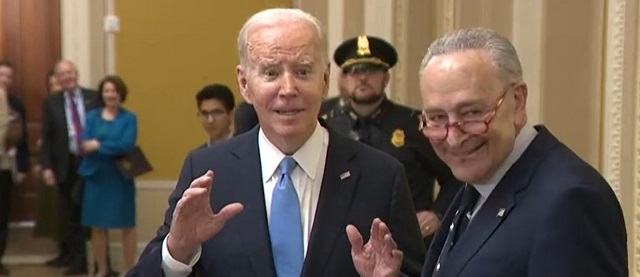International
Chuck Schumer Reportedly ‘Forcefully’ Urged Biden To Drop Out Of Race

 From the Daily Caller News Foundation
From the Daily Caller News Foundation
By HAILEY GOMEZ
Democratic Senate Majority Leader Chuck Schumer is reportedly urging President Joe Biden to end his campaign bid, according to ABC News Chief Washington Correspondent Jonathan Karl.
During an interview on air at the Republican National Convention in Milwaukee, Wisconsin, Karl discussed the “intensifying” pressure that has been building against Biden since his poor debate performance against former President Donald Trump in late June. Karl stated that within a private one-on-one meeting Saturday between the Democratic Senate Leader and Biden, Schumer allegedly “made the case” for the president to step aside as the nominee.
“I am told that the pressure from Democratic leaders for Biden to get out of the race is intensifying. In fact, one person who has been out there publicly defending Biden told me just a short while ago, Biden is going to see the whole house of cards come down soon,” Karl said. “As for that meeting in Rehoboth, Delaware, I am told that this was a one-on-one meeting just the Senate Leader and the president. And that Chuck Schumer forcefully made the case that it would be better for Biden, better for the Democratic Party and better for the country if he were to bow out of the race.”
The White House told the Daily Caller News Foundation that it has no intention of changing its course, and Biden will remain as nominee heading into November.
“The President told both leaders he is the nominee of the party, he plans to win, and looks forward to working with both of them to pass his 100 days agenda to help working families,” White House spokesperson Andrew Bates told the DCNF.
While details weren’t given to the ABC News host, Schumer’s office reportedly told him that the Democratic leader expressed the “views of his caucus.” Karl additionally stated that Democratic House Leader Hakeem Jeffries has also “expressed similar views” to Biden.
“When I went to Schumer’s office to tell them I was going to report this and tell you this tonight, absolutely no denial from Senator Schumer’s office. They only said this, ‘Leader Schumer conveyed the views of his caucus.’ In other words, the views of Democratic senators. I am also told that Hakeem Jeffries, the Democratic leader in the House, has expressed similar views directly to the president,” Karl continued.
Jeffries previously confirmed his meeting with Biden on July 12, telling fellow lawmakers how he “directly expressed the full breadth of insight, heartfelt perspectives and conclusions about the path forward that the Caucus has shared in our recent time together,” according to a dear colleague letter sent by his office.
Exclusive reporting by ABC's @jonkarl: During Schumer's one-on-one meeting with Biden on Saturday, "Schumer forcefully made the case that it would be better for Biden, better for the Democratic party, and better for the country if he were to bow out." pic.twitter.com/eI08ychFt8
— Brian Stelter (@brianstelter) July 17, 2024
Concerns for Biden remaining as the nominee began to circulate late June, with a growing list of Democrats in both the House and Senate vocalizing their stances on having the president step aside. The calls against Biden came after he noticeably struggled to finish his statements during his debate performance, and at one point freezing mid-statement.
Despite his continuous gaffes while speaking and the calls from lawmakers, Biden and his campaign have remained firm in staying in the race. During an interview with BET on Wednesday, Biden stated he would only be open to dropping the race if he develops a medical condition or if doctors suggest he should exit.
In addition to concerns from politicians, a post-debate CBS/YouGov poll found 72% of Americans no longer believe the president has the mental and cognitive health to remain in office, jumping up seven points since their last survey in early June.
Schumer’s office did not immediately respond to the DCNF’s request for a comment.
(Featured Image Media Credit: Screen Capture/CSPAN)
Crime
Bryan Kohberger avoids death penalty in brutal killing of four Idaho students

Quick Hit:
Bryan Kohberger will plead guilty to murdering four Idaho college students, avoiding a death sentence but leaving victims’ families without answers. The plea deal means he’ll spend life in prison without ever explaining why he committed the brutal 2022 killings.
Key Details:
- Kohberger will plead guilty at a hearing scheduled for Wednesday at 11 a.m. local time.
- The plea deal removes the possibility of death by firing squad but ensures life in prison without parole.
- Victims’ families say the state “failed” them by agreeing to a deal that denies them an explanation for the murders.
Diving Deeper:
Bryan Kohberger, a former PhD criminology student at Washington State University, is expected to plead guilty to the November 2022 murders of four University of Idaho students, sparing himself the death penalty but also avoiding any explanation for his motive. Idaho defense attorney Edwina Elcox told the New York Post that under the plea, Kohberger will have to admit to the killings but won’t have to provide a reason for his actions. “There is no requirement that he says why for a plea,” Elcox explained.
Prosecutors reached the plea deal just weeks before the scheduled trial, which many believed would have revealed the full details and motives behind the shocking quadruple homicide. Kohberger is accused of murdering Kaylee Goncalves, 21; Madison Mogen, 21; Ethan Chapin, 20; and Xana Kernodle, 20, with a military-style Ka-Bar knife as they slept in their off-campus home in Moscow, Idaho. His DNA was allegedly found on a knife sheath left at the scene.
The Goncalves family blasted the state for the deal, saying, “They have failed us.” They had hoped a trial would uncover why Kohberger targeted their daughter and her friends. Prosecutors, however, argued that the plea ensures a guaranteed conviction and prevents the years of appeals that typically follow a death sentence, providing a sense of finality and keeping Kohberger out of the community forever.
Sentencing will not take place for several weeks following Wednesday’s hearing, which is expected to last about an hour as the judge confirms the plea agreement is executed properly. While the families may find some closure in knowing Kohberger will never be free again, they are left without the one thing a trial could have provided: answers.
(AP Photo/Matt Rourke, Pool)
International
CBS settles with Trump over doctored 60 Minutes Harris interview

CBS will pay Donald Trump more than $30 million to settle a lawsuit over a 2024 60 Minutes interview with Kamala Harris. The deal also includes a new rule requiring unedited transcripts of future candidate interviews.
Key Details:
- Trump will receive $16 million immediately to cover legal costs, with remaining funds earmarked for pro-conservative messaging and future causes, including his presidential library.
- CBS agreed to release full, unedited transcripts of all future presidential candidate interviews—a policy insiders are calling the “Trump Rule.”
- Trump’s lawsuit accused CBS of deceptively editing a 60 Minutes interview with Harris in 2024 to protect her ahead of the election; the FCC later obtained the full transcript after a complaint was filed.
Tonight, on a 60 Minutes election special, Vice President Kamala Harris shares her plan to strengthen the economy by investing in small businesses and the middle class. Bill Whitaker asks how she’ll fund it and get it through Congress. https://t.co/3Kyw3hgBzr pic.twitter.com/HdAmz0Zpxa
— 60 Minutes (@60Minutes) October 7, 2024
Diving Deeper:
CBS and Paramount Global have agreed to pay President Donald Trump more than $30 million to settle a lawsuit over a 2024 60 Minutes interview with then–Vice President Kamala Harris, Fox News Digital reported Tuesday. Trump accused the network of election interference, saying CBS selectively edited Harris to shield her from backlash in the final stretch of the campaign.
The settlement includes a $16 million upfront payment to cover legal expenses and other discretionary uses, including funding for Trump’s future presidential library. Additional funds—expected to push the total package well above $30 million—will support conservative-aligned messaging such as advertisements and public service announcements.
As part of the deal, CBS also agreed to a new editorial policy mandating the public release of full, unedited transcripts of any future interviews with presidential candidates. The internal nickname for the new rule is reportedly the “Trump Rule.”
Trump initially sought $20 billion in damages, citing a Face the Nation preview that aired Harris’s rambling response to a question about Israeli Prime Minister Benjamin Netanyahu. That portion of the interview was widely mocked. A more polished answer was aired separately during a primetime 60 Minutes special, prompting allegations that CBS intentionally split Harris’s answer to minimize political fallout.
The FCC later ordered CBS to release the full transcript and raw footage after a complaint was filed. The materials confirmed that both versions came from the same response—cut in half across different broadcasts.
CBS denied wrongdoing but the fallout rocked the network. 60 Minutes executive producer Bill Owens resigned in April after losing control over editorial decisions. CBS News President Wendy McMahon also stepped down in May, saying the company’s direction no longer aligned with her own.
Several CBS veterans strongly opposed any settlement. “The unanimous view at 60 Minutes is that there should be no settlement, and no money paid, because the lawsuit is complete bulls***,” one producer told Fox News Digital. Correspondent Scott Pelley had warned that settling would be “very damaging” to the network’s reputation.
The final agreement includes no admission of guilt and no direct personal payment to Trump—but it locks in a substantial cash payout and forces a new standard for transparency in how networks handle presidential interviews.
-

 Business1 day ago
Business1 day agoOttawa Funded the China Ferry Deal—Then Pretended to Oppose It
-

 COVID-192 days ago
COVID-192 days agoNew Peer-Reviewed Study Affirms COVID Vaccines Reduce Fertility
-

 MAiD2 days ago
MAiD2 days agoCanada’s euthanasia regime is not health care, but a death machine for the unwanted
-

 Business1 day ago
Business1 day agoWorld Economic Forum Aims to Repair Relations with Schwab
-

 Alberta2 days ago
Alberta2 days agoThe permanent CO2 storage site at the end of the Alberta Carbon Trunk Line is just getting started
-

 Alberta1 day ago
Alberta1 day agoAlberta’s government is investing $5 million to help launch the world’s first direct air capture centre at Innisfail
-

 Business2 days ago
Business2 days agoMunicipal government per-person spending in Canada hit near record levels
-

 Business1 day ago
Business1 day agoA new federal bureaucracy will not deliver the affordable housing Canadians need






